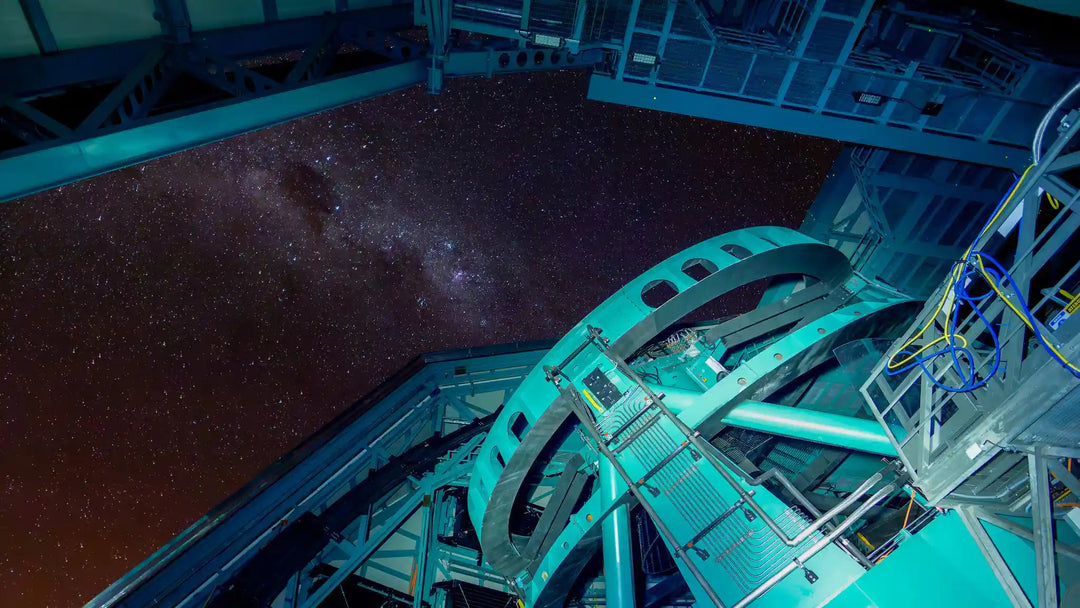TOP 15 Most Powerful Cassini Images

NASA's Cassini spacecraft has provided humanity with some of the most breathtaking images of Saturn and its moons. Over its 13-year mission, Cassini captured more than 450,000 images, revealing the beauty and complexity of our solar system. In this article, we delve into the Top 15 Most Powerful Cassini Images, each a testament to the grandeur and mystery of our solar system. (Of course, this is our subjective choice - we are curious about yours 🙂)
Cassini images: Quintet of Moons
One of the most captivating images taken by Cassini features a quintet of Saturn's moons. Captured on July 29, 2011, this portrait shows Janus, Pandora, Enceladus, Rhea, and Mimas in a stunning arrangement. The image was taken from approximately 1.1 million kilometers (684,000 miles) away from Rhea, and 1.8 million kilometers (1.1 million miles) from Enceladus, showcasing the delicate dance of these celestial bodies as they orbit Saturn.
Janus: 179 km (111 miles) across
Pandora: 81 km (50 miles) across
Enceladus: 504 km (313 miles) across
Rhea: 1,528 km (949 miles) across
Mimas: 396 km (246 miles) across
Image scale is 7 kilometers (4 miles) per pixel on Rhea and 11 kilometers (7 miles) per pixel on Enceladus.

This is not only image of the moons. This picture highlights the gravitational interactions between the moons and Saturn’s rings.
The arrangement of these moons provides insight into their orbital dynamics and the influence of Saturn's gravity on their paths. but also provides a glimpse into the intricate structure of Saturn's rings beyond them.
So Far From Home
In one of its final images taken on October 28, 2016, Cassini captured a poignant view of Saturn and its rings from a distance of 870,000 miles (1.4 million kilometers). This image symbolizes the end of an era as it reflects on Cassini's long journey through the Saturnian system.
The northern hemisphere of Saturn is bathed in sunlight for the first time since Cassini's arrival in 2004, marking a significant seasonal change. The image combines red, green, and blue spectral filters to create a vibrant view that encapsulates both beauty and scientific value

This image marks the transition of seasons on Saturn and allows scientists to study long-term atmospheric changes that occur over Saturnian years.
The image scale is 50 miles (80 kilometers) per pixel.
Colorful Colossuses and Changing Hues
Cassini's observations of Titan, Saturn's largest moon, reveal its dynamic atmosphere and seasonal changes.
This image showcases Titan alongside Saturn, highlighting how Titan's south pole has developed a vortex since 2012. The changing hues in Titan's atmosphere are attributed to varying ultraviolet light intensity as seasons shift.
(Titan: Larger than Mercury at 5,150 km (3,200 miles) across)
The contrasting colors not only illustrate atmospheric phenomena but also hint at potential habitability beneath Titan’s icy crust. Titan has a complex atmosphere rich in hydrocarbons. The changing hues reflect seasonal atmospheric dynamics that could inform studies about prebiotic chemistry relevant to life.

The Cassini spacecraft's wide-angle camera captured these images on May 6, 2012, from about 483,000 miles (778,000 kilometers) away from Titan. The images feature a scale of 29 miles (46 kilometers) per pixel on Titan.
The Day the Earth Smiled (known also as Cassini Pale Blue Dot)
On July 19, 2013, Cassini captured a historic image that included Earth from nearly 1.5 billion kilometers (almost a billion miles) away . This event marked the third time Earth was photographed from such a distance and was celebrated globally.
The mosaic comprises 141 images, revealing Saturn's rings and seven moons against the backdrop of our home planet. This unique perspective emphasizes our place in the cosmos and showcases the intricate beauty of Saturn’s ring system.
This event engaged the public like never before, allowing people to wave at Saturn while Cassini took their picture—a unique blend of science and human connection.
Circling Saturn
Captured in visible light by Cassini's wide-angle camera on August 14, 2014, this image presents an almost surreal view of Saturn’s rings seen edge-on. The shadows cast by the rings create an ethereal effect on the planet’s surface.
This photograph illustrates how different moons like Tethys and Mimas orbit slightly inclined to the ring plane, adding complexity to our understanding of their orbits. The shadows provide insight into the ring structure and dynamics, revealing how they interact with sunlight and affect atmospheric conditions on Saturn.
This image was taken from a distance of roughly 1.1 million miles (1.7 million kilometers) from Saturn. The view was obtained at a Sun-Saturn-spacecraft angle, or phase angle, of 23 degrees, with an image scale of 63 miles (102 kilometers) per pixel.

Cassini Photos: The Rose
One of Cassini’s most striking images is that of Saturn’s north polar storm resembling a giant red rose .
Captured on November 27, 2012, this false-color image reveals cloud speeds reaching up to 330 mph (150 m/s) within a storm eye measuring 1,250 miles (2,000 km) across.
The colors represent varying altitudes within the storm clouds—red for low clouds and green for higher ones—providing insights into atmospheric dynamics on Saturn.
The images were taken with the Cassini spacecraft narrow-angle cameran, ousing a combination of spectral filters sensitive to wavelengths of near-infrared light. The images filtered at 890 nanometers are projected as blue. The images filtered at 728 nanometers are projected as green, and images filtered at 752 nanometers are projected as red.

The view was acquired at a distance of approximately 261,000 miles (419,000 kilometers) from Saturn and at a sun-Saturn-spacecraft, or phase, angle of 94 degrees. The image scale is 1 mile (2 kilometers) per pixel.
This observation helps scientists understand storm systems on gas giants.
Faint D Ring
In this image taken on February 11, 2015, Cassini showcases the faint D ring alongside the more prominent C ring. The D ring is less dense and poses potential hazards to spacecraft due to its thinness.
This photograph highlights not only the visual beauty but also serves as a reminder of the challenges faced by spacecraft navigating these delicate structures. The D ring's thinness poses risks to spacecraft due to potential impacts from small particles; studying it enhances our understanding of ring formation and dynamics.
Taken with Cassini's narrow-angle camera in visible light, the image was snapped from about 372,000 miles (599,000 kilometers) away from Saturn. The Sun-Saturn-spacecraft angle, or phase angle, was 133 degrees, with an image scale of 2.2 miles (3.6 kilometers) per pixel.

Saturn in the Infrared
Cassini provided stunning infrared views of Saturn’s clouds on July 20, 2016. The false-color representation allows scientists to study atmospheric conditions more effectively by highlighting different wavelengths.
This innovative imaging technique reveals patterns within Saturn’s atmosphere that would otherwise remain hidden in visible light. Infrared imaging allows scientists to study temperature variations and chemical compositions within Saturn’s atmosphere.

Basking in Light
In September 2016, sunlight illuminated Saturn’s north pole for the first time since Cassini's arrival. This view captures seasonal changes as well as intricate weather patterns developing in response to solar radiation.
The hexagonal jet stream at the north pole is particularly striking in this image, emphasizing how seasons affect atmospheric dynamics on gas giants like Saturn. This view captures seasonal weather patterns as well as atmospheric changes that occur as seasons shift on gas giants.
This view showcases the sunlit side of Saturn's rings from approximately 51 degrees above the ring plane. Captured by Cassini's wide-angle camera, the image employed a spectral filter that selectively captures near-infrared light centered at 728 nanometers.

This photograph was taken from a distance of about 750,000 miles (1.2 million kilometers) from Saturn, with an image scale of 46 miles (74 kilometers) per pixel.
Colorful Structure at Fine Scales
These are the highest-resolution color images ever captured of Saturn's rings, depicting a section of the inner-central part of the planet's B Ring. The view is composed of a mosaic of two images showing a region that spans between 61,300 and 65,600 miles (98,600 and 105,500 kilometers) from Saturn's center.

Taken on July 6, 2017 with Cassini's narrow-angle camera, the image was acquired from the sunlit side of the rings at a distance of 47,000 miles (76,000 kilometers) from the area shown.
The image scale is about 2 miles (3 kilometers) per pixel, and the phase angle, or the angle between the Sun, the rings, and the spacecraft, is 90 degrees.

These images reveal sharp boundaries between different ringlets and bands that have intrigued scientists for years.
Understanding these structures can lead to insights into ring formation and evolution over time.

Storm Head in False Color
Captured during early storm development on December 24, 2010, this false-color composite illustrates varying cloud depths in Saturn’s atmosphere.
This view captures the southern, shadowed side of Saturn's rings from just below the ring plane. The images were taken with Cassini's wide-angle camera, utilizing a combination of spectral filters sensitive to near-infrared light wavelengths. The 890-nanometer filter is displayed as blue, the 728-nanometer filter as green, and the 752-nanometer filter as red.
The colors indicate different altitudes affected by methane absorption—essential for understanding storm dynamics.

The view was obtained from approximately 1.2 million miles (1.9 million kilometers) away from Saturn, with a Sun-Saturn-spacecraft angle, or phase angle, of 71 degrees. The image scale is about 89 miles (143 kilometers) per pixel.
Enter the Vortex ... In Psychedelic Color
This dramatic image highlights storms at Saturn’s north pole with vibrant colors representing different atmospheric layers. Taken with near-infrared filters, it provides crucial data about storm intensity and frequency.
With this filtering: 890 nanometers is shown in blue, 728 nanometers in green, and 752 nanometers in red.
On Saturn, this color scheme reflects different altitudes in the planet's polar atmosphere: red indicates deeper layers, while green indicates higher-altitude clouds.

High clouds often signal intense storm updrafts, providing insights into the distribution and frequency of such storms.
The rings appear bright blue in this scheme due to the absence of methane gas between the ring particles and the camera.
Understanding storm intensity and frequency helps scientists learn about atmospheric processes that may be similar elsewhere in our solar system or beyond.
The images were taken from approximately 261,000 miles (419,000 kilometers) away from Saturn, at a Sun-Saturn-spacecraft angle of 94 degrees. The image scale is 13 miles (22 kilometers) per pixel.
Bursting at the Seams: The Geyser Basin of Enceladus
On November 21, 2009, Cassini captured stunning views of geysers erupting from Enceladus' south pole.
These images were captured by Cassini's narrow-angle camera through the clear filter during a close flyby of Enceladus. The vantage point was roughly 7.5 degrees south in sub-spacecraft latitude, with a sub-spacecraft west longitude of about 195 degrees on Enceladus.
Taken from a distance of approximately 9,000 miles (14,000 kilometers) from Enceladus, the images were captured at a sun-Enceladus-spacecraft angle, or phase angle, of 145 degrees. The spatial scale of the images is 266 feet (81 meters) per pixel.
From left to right, the fractures are named Alexandria, Cairo, Baghdad, and Damascus. This survey led to the discovery of 101 geysers: 100 were found along one of these "tiger stripes," and the three-dimensional configurations of 98 geysers have been determined. The exact source location of the remaining geyser remains unidentified.
These geysers suggest potential habitability for microbial life due to hydrothermal activity beneath the surface—one of the most significant discoveries regarding extraterrestrial life potential.
A Fractured Pole
During a flyby on October 14, 2015, Cassini revealed Enceladus' north pole landscape filled with fractures rather than craters. This unexpected finding reshapes our understanding of Enceladus' geological history and suggests ongoing geological activity that may support life.
Scientists initially anticipated the north polar region of Enceladus to be heavily cratered, echoing low-resolution images from the Voyager mission. However, high-resolution images from Cassini reveal a landscape of stark contrasts.
Thin cracks traverse the pole, marking the northernmost reach of a global fracture system. Prior to this Cassini flyby, it was unclear whether these fractures extended so far north on Enceladus. In the image, north on Enceladus is oriented upward.

Captured in visible green light with the Cassini spacecraft's narrow-angle camera, the view was taken from roughly 4,000 miles (6,000 kilometers) away. The Sun-Enceladus-spacecraft angle was 9 degrees, with an image scale of 115 feet (35 meters) per pixel.
The Saturnian Sisters
Saturn's moons, Tethys and Rhea—similar in many ways—share even their discoverer: Giovanni Cassini, after whom the NASA spacecraft capturing this view is named. These moons are named after sisters, the Titans from Greek mythology.
Despite size differences, with Rhea being 949 miles (1,527 kilometers) across and Tethys 660 miles (1,062 kilometers) across, both are medium-sized moons, large enough to have rounded into spherical shapes. Composed largely of ice, both moons are considered to be geologically inactive today.
The image looks toward the anti-Saturn sides of Tethys and Rhea, with north oriented up on both. Captured in visible red light by Cassini's narrow-angle camera on October 11, 2015, the moons appear close together in the image.

However, Tethys was actually about 220,000 miles (360,000 kilometers) farther from Cassini at the time, nearly the distance from Earth to our moon, meaning the view does not accurately depict their relative sizes.
Their close proximity in this photograph allows for comparative studies between these two icy bodies that share similar compositions but have distinct geological histories.
The image was taken from approximately 708,000 miles (1.14 million kilometers) away from Rhea, with an image scale of 4 miles (7 kilometers) per pixel. Tethys, at the time, was 930,000 miles (1.5 million kilometers) away, resulting in a scale of 6 miles (9 kilometers) per pixel.
Cassini's Images: Summary
Cassini’s mission to Saturn has profoundly expanded our cosmic horizons, offering a rich tapestry of visual stories that echo the grandeur and mystery of the solar system. Each image captured by this mission serves as a lasting reminder of the wonders beyond our home planet.
Key Takeaways
Cassini captured over 450,000 images, transforming our understanding of Saturn.
Significant discoveries include liquid water on Enceladus and complex atmospheric dynamics on Titan.
Historic events like "The Day the Earth Smiled" engaged global audiences with space exploration.
Each image provides insights into seasonal changes and geological processes occurring across the Saturnian system.
FAQs: You Ask, We Answer
What is NASA's Cassini mission?
A mission launched in 1997 to study Saturn and its moons for over two decades.
How many images did Cassini capture?
More than 450,000 images were sent back to Earth during its mission.
What is unique about Titan?
It has lakes of liquid methane and is larger than Mercury.
How did Cassini contribute to our understanding of planetary atmospheres?
By capturing detailed images showing weather patterns and seasonal changes.
How does Cassini's imagery differ from other missions?
Its long-term observations allowed for studying seasonal changes over time.
What was "The Day the Earth Smiled"?
An event where Earth was photographed from nearly a billion miles away. Buy your item: Cassini's Pale Blue Dot.
What legacy did Cassini leave behind?
A wealth of data that continues to inform planetary science today. Find out more about the most influential Cassini’s discoveries.
Resources
- https://science.nasa.gov/resource/quintet-of-moons/ [7.10.2024]
- https://ciclops.org/view/8593/So-Far-from-Home.html [7.10.2024]
- https://science.nasa.gov/resource/colorful-colossuses-and-changing-hues-2/ [7.10.2024]
- https://ciclops.org/view/7699/The-Day-the-Earth-Smiled.html [7.10.2024]
- https://science.nasa.gov/resource/circling-saturn/ [7.10.2024]
- https://ciclops.org/view/7495/The-Rose.html [7.10.2024]
- https://ciclops.org/view/8008/Faint-D-Ring.html [7.10.2024]
- https://ciclops.org/view/8408/Saturn-in-the-Infrared.html [7.10.2024]
- https://ciclops.org/view/8443/Basking-in-Light.html [7.10.2024]
- https://ciclops.org/view/8613/Colorful-Structure-at-Fine-Scales.html [7.10.2024]
- https://ciclops.org/view/6680/Storm-Head-in-False-Color.html [7.10.2024]
- https://ciclops.org/view/7497/Enter-the-Vortex-In-Psychedelic-Color.html [7.10.2024]
- https://ciclops.org/view/7908/Bursting-at-the-Seams-the-Geyser-Basin-of-Enceladus.html [7.10.2024]
- https://ciclops.org/view/8236/A-Fractured-Pole.html [7.10.2024]
- https://ciclops.org/view/8215/The-Saturnian-Sisters.html [7.10.2024]
- NASA Science, Saturn's Magnetosphere: Overview , [7.10.2024]
- NASA Science, Nine Ways Cassini-Huygens Mattered , [7.10.2024]
- D. Chow, Cassini's Greatest Hits: Best Photos of Saturn and Its Moons, LiveScience , [7.10.2024]
- C. Cofield, Cassini’s Greatest Hits: The Spacecraft’s Best Images of Saturn, space.com , [7.10.2024]




















![Vera C. Rubin Observatory: Revolutionizing Astronomy Through the World's Most Advanced Telescope [All You Need To Know]](http://astrography.com/cdn/shop/articles/vera-c.-rubin-observatory_main.webp?v=1751627507&width=1080)

Leave a comment